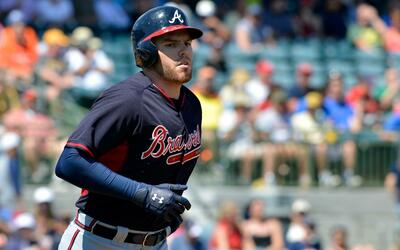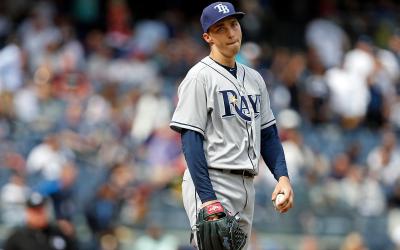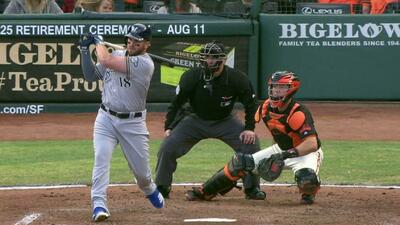April's Under/Over Performing Batters
Another April is almost in the books and as typical there are quite a few players who are in our doghouse and a quite a few players who have the keys to the penthouse...but who deserves to be where?
For those who are new to Fantistics, here it is: "All Major league Players streak!": The "confusion" comes when these "good or bad" streaks occur during the early portion of the season. "Are they just an aberration or are they a long term trend that will carry through to seasons end?"...luckily, based on our research, we have an answer...in over 80% of the cases among veteran position players, they are a statistical anomaly that will inevitably get "swallowed" and disappear after a full season of games. The formal statistical term is "reversion or regression to the mean", over a full term season (550'ish plate appearance) experienced major league players tend to revert back to their typical category statistics, of course some will exceed and some will decline which is already assumed in our projections.Â
For the veteran fantasy player, the quandary we often face is trying to figure out which of the first and sometimes second year players are going to maintain their current production. History tells us that over 1/2 of the current "up trending" (over performers) first year players are going to fall into serious slumps after June. As the pros say: "their book is out" (where pitchers from around the league figure out how to get these guys out). Ian Kinsler is a rising young star, however his current pace is unsustainable based on his minor league history: expanded over a full season .333 BA/116 Runs/62 HR/147 RBI...not happening. Please realize that I'm not advocating to sell Kinsler cheaply, as we were very high on Kinsler coming into the season and we expect him now to exceed our lofty pre season expectations. However we all know that he's not going to maintain a 1.170 OPS through the remainder of the season (only 1 - 3% of the players accumulate an OPS of over 1.000 in any given season). If you could get his current Roto Value in a trade (Kinsler for an underperforming player like Lance Berkman), then it might be foolish not to...if not, he is certainly worth the keep.
Using Advanced Stats to Determine Value
Our Advanced Stats Database contains some of the baseball stat indicators that we use to analyze performance during the season. The Advanced Stats Database contains many of the widely recognized indicators along with our Fantasy Production Indicator (FPI).Â
For our new readers, it's important to understand the significance of FPI, its really a great indicator to grab on to, and can provide you with a real quick understanding of value. Seeing OF Jose Cruz Jr at a .90 FPI (Albert Pujols FPI zone) is a glaring indication to cash in at a premium.Â
Patience is the key to Winning a Fantasy Championship
Not all the answers will be found using FPI, but a great many may. As mentioned, a large percentage of the batters will fall in line our preseason FPI projections (within +/- 10%). The concept of reversion to the mean holds high esteem among veteran players. Sure, every year you'll have the player who posts a monster season out of the blue, but these are the exceptions, and are very rare indeed. Early on during a season, the key to all successful fantasy campaigns is patience for the under producing players on our team!
Strategy Plus: Understanding the Analysis
Presented in the datasheet are rankings based on where the typical 5x5 league would value players. This may not match your league scoring, however if you use it on a relative basis you can still gain benefit. The first column in the grid below represents my ranking of the players based on their potential moving forward. This ranking is not based on a specific formula, however I have considered factors such as reversion to the mean (preseason projections) and the Advanced Stat indicators which you will see listed. The second column represents the current YTD ranking based on the $ values of a typical 5x5 league. The 3rd column is the Preseason Rank again based on the $ values of a typical 5x5 league.
The advanced stat columns include the indicators BHIPx% (For more on Singles percentage, visit this link for a definition), EYE (BB/K - explanation), and change in EYE verses the players ratio in 2006. In a nut shell, BHIPx% rates below .200 indicate that the player has been unlucky on balls hit into play, and rates above .300 indicate that the player has been lucky on balls hit into play (as more than their fair share have fallen for base hits). The league average is approximately .250. EYE gives us an indication whether a player's hot start is sustainable based an improvement in his strike zone discipline.
The 2007 Expanded Stats section are simply the year to date stats, expanded over an entire season. It is based on the assumption that the player's production will continue exactly as it has over the first 20'ish games. It is included in the analysis so that we can gauge how realistic the player's current production is or is not. The OPS column represents the On Base + Slugging Percentages for these players. As a reference, last year only 9 full time players attained an OPS above 1.000. Among this rank were D. Ortiz, A Ram, A. Pujols, R. Howard, T. Hafner, L. Berkman, J. Thome, C. Jones, and J. Dye . In general anything around .800 is considered average, with only 10% attaining a OPS value over .900 in 2006.
The Column labeled "PreS $" is the preseason projection dollar valuation for the given player. It's included next to the 2007 $ valuation to give you a gauge of the players current (not future) performance.
The Key columns to look at are the FPI Columns. Â The FPI Change column, shows how much better or worse a player is doing (see FPI) YTD through Wednesday (4/25) verses our preseason projection. The desirable situation is that you, as a fantasy GM, can trade the "over producers" at their current (2007 $ column) worth and buy them at their projected worth (PreSeason $ column)...the reverse would hold true for the "under producers". The Under producing players have their FPI change highlighted in Blue (greater than -10) and the overachievers have their FPI change highlighted in Red (greater than 10)
The Recommend column is our recommended course of action: Buy or Sell.
Click here for the report: http://www.fantistics.com/baseball00/StrategyPlus-Hitters-May2007.pdf
Next week we'll cover the Pitchers, see you then.
-Anthony A. Perri
Statistician and Publisher





















